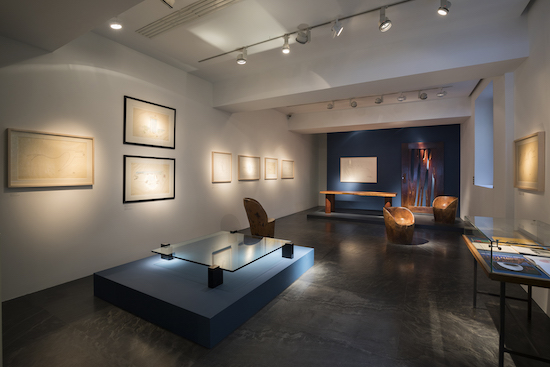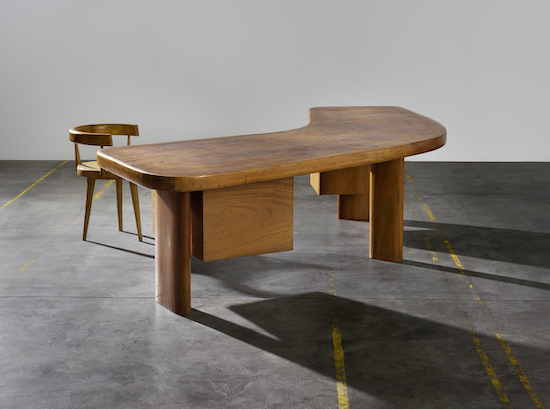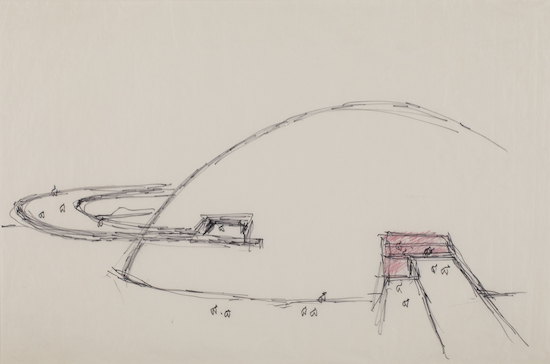Oscar Niemeyer, Collage sans titre © Tom Shapiro Laffanour Galerie Downtown, Paris
“I’m not attracted to straight angles or to the straight line, hard and inflexible, created by mind. I am attracted to free-flowing, sensual curves. The curves that I find in the mountains of my country, in the sinuousness of its rivers, in the waves of the ocean, and on the body of the beloved woman. Curves make up the entire Universe, the curved Universe of Einstein.” – Oscar Niemeyer
Taking a walk south through Paris, across the river and down to Montparnasse I took the Rue de Seine, casually glancing in the galleries on both left and right, zig-zagging across the road. I knew I was not going to return this way, so anything interesting had to be hunted out then and there. Which was when I saw the Laffanour Galerie had a Tropicalism exhibition featuring work from a long-admired figure, Oscar Niemeyer.
Tropicalism is a contested movement these days, criticised for softening racism with its soft lines. It has been used, it is said by some to be a movement that implies Portugal and Portuguese Brazil is not so racist because of this friendly, warm aesthetic. Yet it continues to lure me and many others in, made attractive by the soundtrack by Caetano Veloso, bossanova, the guitar work of Jobim. Sensual, musical and perceived as exotic, Tropicalism provides one answer to national assertion from those who did not want to present their new country of Brazil as one of aggressive colonisation. Many artists who characterised the regime were politically active, demonstrating for freedom against torture, and using art and design to oppose the climate of dictatorship.
The Laffanour Galerie room is darker than most white-walled boxes, with a more domestic feel. It suits the softness of this architectural movement. The low lighting affects me gently, reflecting Niemeyer’s aesthetic interiors, his softening of atmospheres, the warmness of his line.
Niemeyer’s interests may have many uncomfortable associations these days for a critical enlightened gaze, such as his objectifying of the female form and its appropriation for building design, but his development of an architecture that goes beyond the conventions of technical drawing or the box is presented well in this small, perfectly formed exhibition.
His work is framed with bright viridian, which carefully chosen vivid shade forms the signature colour of the show. A mid-green accent wall boldly painted, the splendid leaflet echo one of Niemeyer’s collages. In it a tissue of green reveals an opening through which a couple are viewed. The feelings of the forest are brought inside the realm of architecture.

Installation view © Tony Shapiro
Sketches of architecture create interesting artworks in themselves. A hand lets water flow over its palm, reaching up above the diminutive passers-by. It’s humorous but not aggressively so. The sketch of a school on green grass on the off-white tissue is delightfully abstract with the tender line of the aerial view of its paths and curved buildings. These ‘greenprints’ are far more inviting than blueprints
As an artist I am uncomfortable with the tyranny of the straight line so Niemeyer’s work obviously appeals to me. I find too many architects are in love with the ruler. Niemeyer talks of the “moment of surprise” that architecture can give. Only people with money can benefit from architecture, he says, the rest are fucked up in the slums. No wonder their buildings are alienating.
Niemeyer has spent his life watching the sunsets and sunrises over the mountain, consciously breathing this breath that is existence.
His greenprints show people at leisure, in gentle scenes, lying, walking, holding hands, moving. A giant hand is a waterfall. People walk in couples beneath the impressive sculpture. A dome, like a spaceship, or rather the setting sun, welcomes the wanderers, all executed in thin pen on what looks like washi.
The influence of the line work of Matisse and Picasso is apparent here, and also of the curved wood creations of Jean Arp. But it’s mixed with imagery from space-age cartoons of the 1950s. The work of standout background artists working for Disney in the 1950s come to mind.

Charlotte Perriand, Grand bureau © Marie Clerin Laffnour Galerie Downtown Paris
Against the strong delicacy of these images there are the thick hewn furniture and sculpture of French architect Charlotte Perriand. When based in Brazil, she built a modernist home using exceptional wood. The pieces are both domestic, influenced by the curves of Thonet’s bentwoods for her stand out piece, the chaise longue she designed with Le Corbusier. These are bigger, prestigious pieces.
Perriand’s experience in Brazil is little discussed in general overviews of her work so this little but carefully curated exhibition is filling a knowledge gap in art culture as well as showing worthwhile pieces. These desks and tables are the opposite of disposable and fight against the concept of throwaway. The more we think like this with our homes, the less we may destroy the planet with our destructive wrapping and our temporary items. This show is in tune with contemporary directions.

Oscar Niemeyer © Tom Shapiro / Laffanour Galerie Downtown, Paris
The third artist José Zanine Caldas is the least known to me. Whereas Perriand left Brazil and its cinema scene in 1968 Caldas went further, bringing Amazonia inside the domestic environment. In 1964, during the military coup, Zanine had lost his position at the University of Brasilia and began carving solid furniture from local woods. His works displayed here take advantage of the cracks and natural twists of pequi, acajour and vinhático. Pequi has a wide cultural presence in the Cerrados as a tree whose pulp flavours drinks and rice. The rugged furniture gives a sense of roots, localism and responsibility.
Odd and squashed next to the Seine, this exhibition is a little miracle, three artists suggesting expansive greenery, forests and mountains and hefty, organic, long-lasting forms. An art breathing steadily here, on the side of the city street like the beating heart of a tree. As to the negative view of the softening effects of Tropicalism, the current rise of pro-gun, inflammatory speech in Brazil is creating such a hard appearance that my political criticism is taken up by those waging war on the rainforest and the divisive mindset targeting indigenous and ‘other’ people. Thinkers and designers like Caldas, Perriand, and Niemeyer, as presented in this small, friendly Parisian space, have contributed work to the resistance.
Tropicalism: Charlotte Perriand, Oscar Niemeyer and Zanine Caldas, is at Laffanour Galerie Downtown, Paris, until 10 November 2018


